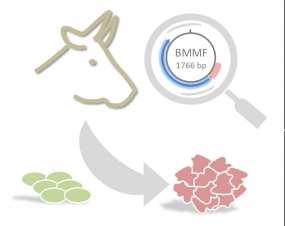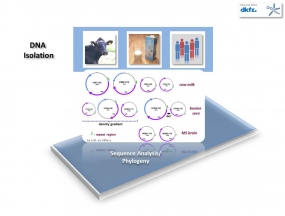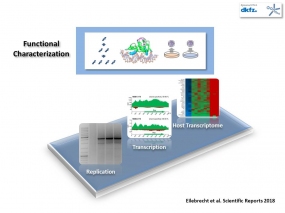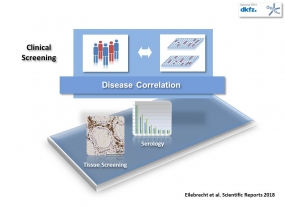Our friend, mentor and supporter Harald has left us. The emptiness and sorrow is unbearable. We aspire his scientific mission to continue. In gratefulness, sorrow and memory.

INTRODUCTION
Albeit we currently know a large set of cancer risk factors such as direct carcinogens and associated (viral) cancer driver genes, cancer driver mutations and a large selection of systemic/environmental risk factors, we still fail to understand the early causative steps in tumourigenesis of the largest part of cancers. Although uniting features – e.g. the involvement of chronic inflammation and the interplay of several indirect cancer risk factors in tumourigenesis - are broadly accepted, recent synergism analyses pointing e.g. at known indirect carcinogens or the microbiome seem to be incomplete. We specifically addressed the epidemiologic association of certain types of cancer, in particular chronic inflammation (CI)-linked colorectal cancer (CRC), breast cancer (BRCA), prostate cancer (PRAD), liver cancer (HCC), pancreatic cancer (PDAC) and others with the consumption of bovine meat and milk products. The link of high cancer incidences and high meat and milk consumption on the regional level suggests a causative contribution of zoonotic-linked infectious agents - such as Bovine Meat and Milk Factors (BMMF) broadly identified in bovine meat and milk - in indirect carcinogenesis (e.g. zur Hausen, 2012, Int J Cancer, zur Hausen & de Villiers, 2014, Sem Oncol, zur Hausen, 2015, Clin Oncol, zur Hausen, 2017, Curr Top Microbiol Immunol, zur Hausen H et al, 2018, Int J Cancer).
BMMFs are frequently isolated from bovine meat and milk samples but also from human material (de Villiers et al, 2019, Emerg Microbes and Infect) and might represent bioactive risk factors for the development of some of the most common human diseases like e.g. breast and colon cancer, but also neurodegenerative disease like Multiple Sclerosis, Alzheimer's and Parkinson's Disease. Positive results might result in novel options for diagnosis and specific disease prevention and treatment (zur Hausen and de Villiers, 2021, Cancer).
We apply basic research for the development of new translational tools and technology for diagnosis and intervention which we test in preclinical models with the aim to generate real-world cancer prevention.
IN THE BEGINNING…
Within several decades of intensive research, Harald zur Hausen and Ethel-Michele de Villiers laid the foundation for the identification and general understanding of a multitude of previously unknown viruses culminating in the 2008 Nobel Prize in Physiology or Medicine for Harald zur Hausen "for his discovery of human papilloma viruses causing cervical cancer" (the other half jointly to Françoise Barré-Sinoussi and Luc Montagnier "for their discovery of human immunodeficiency virus"), paving the way for a new understanding of virology and successful vaccination strategies for cervical cancer (Reference Center and later international WHO reference center for Human Papillomaviruses chaired by E.-M. de Villiers from 1984 to 2013). They further focused on the identification of novel groups of viruses as possible causative agents for common human diseases. A careful analysis of epidemiologic aspects (e.g. dietary habits) of specific human diseases has led to the current focus on isolation and identification of formerly unknown putative infectious agents from bovine meat and milk products and particularly from cancers of the colon and breast (e.g. de Villiers et al, 2019, Emerg Microbes and Infect). The broad spectrum of identified agents opened up entirely new fields of virology and in 2013, the novel group "Episomal-Persistent DNA in Cancer- and Chronic Diseases" was formed, headed by Harald zur Hausen and Ethel-Michele de Villiers. The group identifies novel infectious agents and their potential disease correlations and prevention strategies. In 2018, it is led by Timo Bund with Harald zur Hausen and Ethel-Michele de Villiers as initiators of these activities as consultants.
CURRENT RESEARCH
Isolation of Bovine Meat and Milk Factors
The group "Episomal Persistent DNA in Cancer- and Chronic Diseases" isolates plasmid-like episomal DNAs mainly from bovine meat (serum) and milk but also from human sample materials (e.g. Gunst et al, Whitley et al, Funk et al, Lamberto et al, Falida et al, 2014-2017, Genome Announc, de Villiers et al, 2019, Emerg Microbes and Infect). The isolates have been termed Bovine Meat and Milk Factors or shortly BMMFs. Epidemiology correlates the consumption of bovine meat and milk with a higher prevalence of e.g. breast and colon cancer on a global scale, pointing towards a zoonotic-linked infection as possible risk factor for disease development (e.g. zur Hausen, 2012, Int J Cancer, zur Hausen & de Villiers, 2014, Sem Oncol, zur Hausen, 2015, Clin Oncol, zur Hausen, 2017, Curr Top Microbiol Immunol, zur Hausen H et al, 2018, Int J Cancer). Importantly, BMMFs were also isolated from patients suffering Multiple Sclerosis. Additionally, degradation-resistant DNAs comparable to BMMFs were found in scrapie-particle preparations (Manuelidis, 2011, J Neurovirol) whereas BMMF-related proteins were identified in mouse and hamster CNS as well as human glioblastoma (Yeh et al, 2017, Proc Natl Acad Sci U S A) indicating a possible link with neuronal diseases. More recently, additional plasmid-like DNA elements with high sequence similarity to BMMF were isolated from goat and sheep milk and milk from water buffalos living in German zoos (König et al, 2021, Viruses).
Functional Characterization of Bovine Meat and Milk Factors
We assessed bioactivity of specific BMMFs in human cells. Therefore, transfection experiments with different types of BMMF were performed in a human cell line model showing replication, transcription and translation of BMMF genes (Eilebrecht at al, 2018, Scientific Reports). Analysis of phenotypic changes in the human host cells were characterized together with specific host transcriptome analysis based on RNA Seq indicating the use of "humanized" transcription/translation control elements.
Assessing the causative contribution of BMMF to CRC
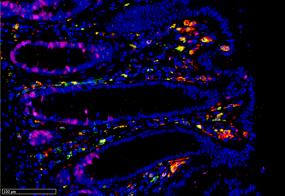
Microsopic immunofluorescence staining of peritumor colon mucosa of a CRC cancer patient showing BMMF Rep staining (green) in CD68+ positive macrophages (red) in the Lamina propria between the colonic crypts and in close vicinity of Ki67+ replicative crypt stem cells and early daugther cells (magenta). BMMF staining is observed next to the apical ends of the crypts (right) as well as close to the basal replicating crypt cells (left).
© dkfz.de
To investigate the causative role of BMMF in early tumourigenesis, we developed and evaluated a set of DKFZ-built BMMF antibodies for detection of a conserved BMMF protein (Rep) (Bund et al, 2021, Proc Natl Acad Sci U S A) from a BMMF representative, for which bioactivity (replication, transcription and translation of BMMF genes) was shown in human BMMF cell models, before (Eilebrecht et al, 2018, Sci Rep). A partial structure of the Rep antigen, which was used for the DKFZ-built antibody production, was resolved by X-ray crystallography allowing mapping of antibody epitopes and indicating Rep oligomerization (Kilic et al, 2019, Acta Crystallogr D Struct Biol). The antibodies were systematically applied in histochemical staining on CRC tumour and peritumour tissues and revealed Rep expression in peritumour tissues stained by immunohistochemistry (IHC), out of which BMMF DNA was isolated by laser microdissection (de Villiers et al, 2019, Emerg Microbes Infect).
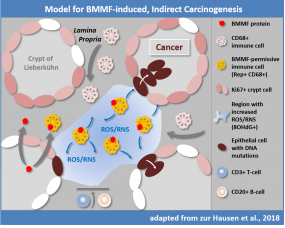
Model for the contribution of BMMF to the indirect carcinogenesis of CRC (Bund T et al, 2021, Proc Natl Acad Sci U S A, modified, based on the model by zur Hausen et al. 2018 and previous publications).
© dkfz.de
Rep expression was increased in the peritumour mucosa of CRC patients when compared to healthy controls and linked with increased levels of CD68+ macrophages (basic marker for chronic inflammation (CI)) and 8OHdG (surrogate marker for ROS/RNS radical-induced DNA oxidation) indicating a causative contribution of BMMF to CRC based on CI and (random) DNA mutation (e.g. zur Hausen et al, 2018, Int J Cancer, Bund et al, 2021, Proc Natl Acad Sci U S A). The model of BMMF-induced CI, diffusing ROS/RNS, DNA mutation in replicating crypt cells as precursors for polyps and adenocarcinoma is also supported by BMMF expression identified in the stroma of pre-cancerous polyps (zur Hausen et al, 2018, Int J Cancer and previous publications).
The analyses was recently expanded to a larger validation cohort including low and high grade dysplasia (LGD/HGD) as well as a large dataset of CRC donors (tissue microarray, TMA, with n=246) to address a causative contribution of BMMF (Rep) expression on induction of cancer and pre-cancerous stages and the prognostic importance of Rep expression for survival of CRC patients (Nikitina et al, 2023, Mol Oncol, accepted for publication).
We just recently identified BMMF+ macrophage populations in lung cancer (LUAD), a cell population considered relevant for early tumourigenesis and therapy in LUAD (see e.g. Casanova-Acebes et al, 2021, Nature) and for which gene set enrichment analysis is expected to deliver insight into BMMF-driven regulation and ways to interfere with putative BMMF-regulations in the tumor microenvironment (TME).
Ultrastructural analyses of BMMF in colorectal, lung and pancreatic cancer
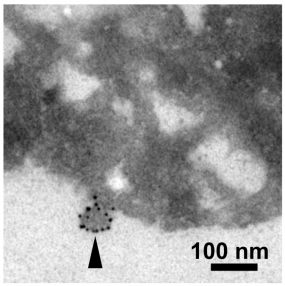
Ultrastructural representation of BMMF in tissues of CRC patients stained with anti-Rep antibody AB3 (Nikitina E et al, 2022, Int J Cancer). FFPE biopsies of CRC (and LUAD and PDAC exocrine and endocrine tissue regions) show 50-200 nm-sized pleomorphic, vesicular structures stained with gold-labeled BMMF antibodies.
© dkfz.de
To further stratify the structure of BMMF targets in human cancer tissues, we applied immuno electron microscopy (pre-embedding and structure-retaining cryo-embedding) in CRC, LUAD, PDAC tissues, which were previously tested positive for Rep expression in histochemistry. In all three cancer types, we identified pleomorphic vesicular structures of 50-200 nm in size in the cytoplasm, most likely of macrophages, with association to membranes (Nikitina et al, 2022, Int J Cancer). This and the accessibility of the epitopes suggest intervention strategies based on blocking, immobilization or neutralization of BMMF targets.
BMMF as common zoonotic-linked, infectious driver of indirect carcinogenesis?
Epidemiology and the link to CI highlight a large group of cancers that might be associated with infectious zoonotic-linked indirect carcinogenesis. In de Villiers & zur Hausen, 2021, Cancers, we outline the hallmarks of indirect carcinogenesis underlining the persistence of the CI-inducing infectious agents over long period of time, no persistence in cancer cells, but in the vicinity. We highlight that cancers induced by indirect carcinogenesis show a decreased incidence in individuals under immunosuppression or under uptake of anti-inflammatory drugs, e.g. in CRC, PDAC, PRAD, BRCA (in part also LUAD and HCC), for which preliminary analyses show BMMF expression in the peritumour tissues both in wet and BMMF reads in in silico analyses.
We currently expand in silico BMMF screening based on the current ~200 known BMMF representatives to the PCAWG cohort including >35 cancer types (many of them linked to CI) to establish a 'BMMF Cancer Atlas' and to address the pathological relevance of specific BMMF targets in these cancers. The BMMF in silico screening already resulted in the generation of antibodies against 4 additional, highly abundant BMMF targets.
Additionally, the use of non-steroidal anti-inflammatory drugs (NSAIDs), human milk oligosaccharides (HMO) and metformin, the latter involved in reduction of the risk of early dysplasia the colon setting, is discussed and will be part of future therapy monitoring.
Dual BMMF and EBV infection in the etiology of Multiple Sclerosis (MS)
Since long, EBV is known as a risk factor for MS. Current studies strongly support an early stage, causative contribution to MS (Bjornevik et al, 2022, Science), but at the same time conclude that a second (strong) risk factor must exist due to the high sero-positivity of EBV in individuals which never develop MS. We proposed the model of a dual infection of the same brain cell with EBV and BMMF (Borkosky et al, 2012, PLoS One, zur Hausen et al, 2017, Curr Top Microbiol Immunol). Upon vitamin D deficiency and concurrent upregulation of and TGF-β, EBV is (re-)activated and stimulates replication of BMMF and synthesis of BMMF proteins. The BMMF antigens will induce an increased concentration of BMMF antigen-reactive antibodies in the peripheral blood of MS patients. We developed a highly sensitive and specific bridging ELISA based on BMMF Rep antigens for the detection of BMMF specific antibodies (support by ORYX Alpha, unrestricted research grant). The test showed significantly increased levels of BMMF antibodies in MS patients when compared to age- and gender-matched non-MS donors. The test aims to overcome existing limitations of MS diagnosis due to the low capacity and high cost of magnetic resonance imaging as the major diagnostic readout and, in addition, allow MS therapy monitoring.
Prognostic relevance of BMMF in CRC – platform for BMMF therapy
We described more previously that BMMF expression is currently quantified based on a TMA with paired CRC tumour and peritumour tissues to asses any causal contributions. To assess whether on top of a causative contribution BMMF might exert a prognostic relevance on patient outcome, we also analyze the association of BMMF expression with patient survival based on a BMMF immunoreactive score. Results are expected to be online, soon.
BMMF Models – Proof of Concept (POC)

In BMMF mouse models we test different types of BMMF exposure (DNA, protein, milk, uptake as nutrition and/or anal exposure, project funded by the World Cancer Research Fund International, in cooperation with Mathias Heikenwälder and Rene Jackstadt) and any possible induction of inflammation in the relevant target organs (colon, lung, liver, etc.). In addition, the effect of BMMF+ immune cells (in particular macrophages) will be tested based on cell culture/organoid models (e.g. colon, liver and lung organoids), to test an effect on the viability and migration of tumour cells. In all pre-clinical models, we will additionally test the effect of a specific class of sugars (Neu5Gc) described as putative BMMF receptor and possible intervention of BMMF-receptor-binding by specific human milk oligosaccharides (HMO) (de Villiers & zur Hausen, 2021, Cancers).
SIGNIFICANT ACCOMPLISHMENTS
Isolation of more than 150 different BMMF isolates – characterization and classification into 4 different groups of BMMF by E-M de Villiers (e.g. de Villiers, 2019, Emerg Microbes Infect and previous) – 2014-2019
We showed for the first time that Bovine Meat and Milk Factors (BMMF) are bioactive in human cells and replicate as well as transcribe/translate a BMMF replication protein (Rep) and induce detectable anti-Rep antibody titers in humans - 2018
Comprehensive review on BMMF protein expression in peritumour tissue (macrophages) in colorectal cancer. Support for the BMMF-based indirect carcinogenesis-hypothesis (see zur Hausen & de Villiers, 2012-2021) with induction of chronic inflammation, radicals and DNA mutations in replicative cells of the colonic crypts, which them,selves are not in contact with BMMF, as precursors for cancer - 2018
First BMMF protein crystal structure (Rep protein). The Rep encoded by a BMMF genome isolated from a Multiple Sclerosis Patient shows structure similarity to prionopathic bacterial RepA - 2019
Finalized production of a set of highly specific anti-BMMF antibodies ready for high throughput testing of clinical samples for identification of BMMF proteins - 2020
BMMF Rep expression in CRC peritumour macrophages was increased in case vs. control and was associated with chronic inflammation, ROS/RNS and DNA mutation suggesting a causative role of BMMF as indirect carcinogen - 2021
Pleomorphic, vesicular structures of 50-200 nm size were identified in colorectal, lung and pancreatic cancer tissues by immuno electron microscopy with BMMF antibodies opening new avenues for diagnosis/prevention - 2022
FUTURE OUTLOOK
Our mission is to apply both tailored wet lab and in silico analysis to concretize the contribution of BMMF to cancer: BMMF profiling to generate a BMMF Cancer Atlas and unravel the molecular background of BMMF infection already in the pre-cancerous stages focusing on chronic inflammation to prove our concept of indirect carcinogenesis. We combine these analyses with pre-clinical models (mouse, organoids and explants) to develop and validate both our tools for BMMF detection and modulation of BMMF (such as antibodies, NSAID, HMO, BMMF-reactive T-cells etc.). A strong focus is on multi-omics analyses on BMMF in (sc)RNA/DNAseq data to identify markers for diagnosis and therapy (live trajections over time and comparative analyses). An additional goal is to allow a BMMF-based stratification of the cancer risk (BMMF test on biopsies at the pre-cancerous stage) or the need for adjusted therapy (therapy monitoring). In the latter, we envision a BMMF-based immunologic re-activation of the TME to modulate or clear pro-tumourigenic BMMF+ macrophages to support anti-tumour response and minimize therapy resistance using the present human chimeric BMMF antibodies. Ongoing research is needed to validate BMMF detection tools and technology to unravel blood-borne BMMF targets and the distribution in the human host, which includes in vitro and in vivo analyses on the BMMF receptor landscape and possible synergism with the microbiome. The project allows access on chronic neurodegenerative diseases (in particular Alzheimer's and Parkinson's Disease) and type 2 diabetes.

